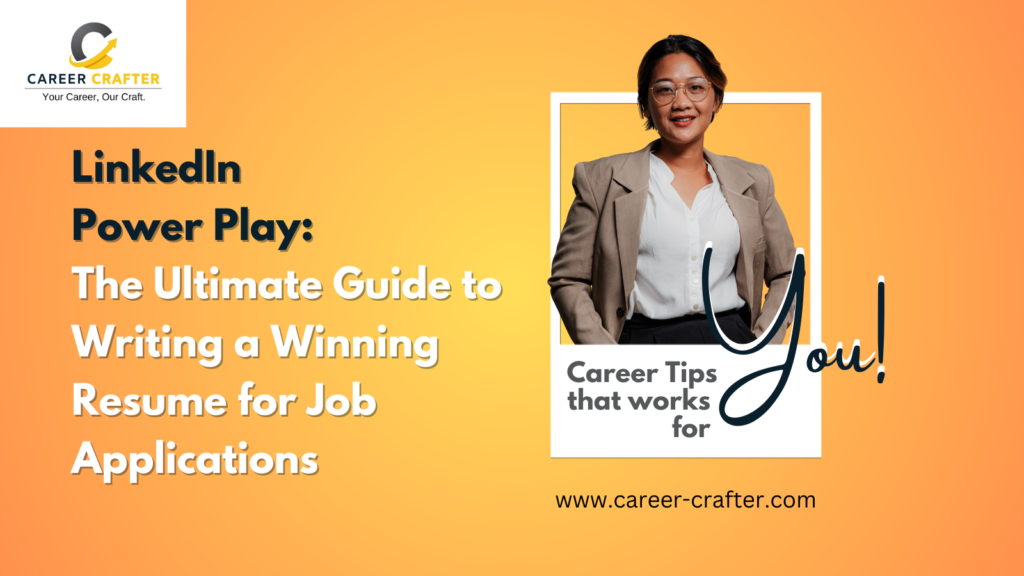“A well-crafted LinkedIn resume is like a magnet, attracting the right opportunities and opening doors to success”
In today’s rapidly evolving job market, LinkedIn has emerged as a powerful platform for professionals to connect, network, and explore new career opportunities. As mid to senior level managers, you understand the importance of a well-crafted resume in catching the attention of recruiters and securing your dream job. However, crafting a resume specifically tailored for LinkedIn job applications can be a daunting task. Fear not! In this comprehensive guide, we will address the common challenges faced by professionals like you and provide you with actionable solutions to write a perfect resume for a LinkedIn job application. Whether you are new to LinkedIn or seeking to optimize your existing profile, this roadmap to success will elevate your chances of landing your desired position.
Identifying the Problem:
1. Insufficiently optimized resumes:
One of the primary challenges faced by professionals on LinkedIn is the difficulty of adapting their traditional resumes to the platform. This often results in a lack of visibility to potential employers and missed opportunities.
2. Uncertainty about resume format:
Many job seekers are unsure about the appropriate file format to upload their resume on LinkedIn, leading to confusion and potential compatibility issues.
3. Inadequate use of keywords:
Without strategic keyword placement, resumes may not rank high in LinkedIn search results, making it harder for recruiters to find them amidst the sea of profiles.
4. Lack of personal branding:
Professionals often struggle to effectively showcase their personal brand, achievements, and unique value proposition on their LinkedIn resumes. This hampers their ability to stand out from the competition.
5. Incomplete or irrelevant information:
A resume that lacks essential details or includes irrelevant information can create confusion and detract from the applicant’s qualifications, diminishing their chances of being shortlisted.
“Your LinkedIn resume is your digital business card, make sure it leaves a lasting impression.
Solutions:
1. Optimize your resume for LinkedIn:
Tailoring your resume to reflect your personal brand and career goals is vital for making a lasting impression on potential employers. Here’s how to optimize your LinkedIn resume effectively:
a. Create a Compelling Headline: Craft a concise and attention-grabbing headline that showcases your expertise, industry, and career focus. For example, “Senior Marketing Executive | Digital Strategy Expert | Driving Business Growth.”
b. Craft an Engaging Summary: Utilize the Summary section to highlight your key achievements, skills, and value proposition. It should provide a compelling overview of your professional journey and what sets you apart.
c. Highlight Relevant Skills: Leverage the Skills section to showcase your core competencies. Incorporate industry-specific keywords and ensure that the skills listed align with your target job.
d. Showcase Recommendations: Request and display recommendations from colleagues, clients, or supervisors to boost credibility and showcase your professional reputation.
2. Choose the right resume file format:
Selecting the appropriate file format for your LinkedIn resume is crucial to ensure consistency and readability across different devices. Follow these best practices:
a. Opt for PDF: Save your resume as a PDF document to maintain consistent formatting and ensure compatibility across various platforms. PDF files preserve the layout and design of your resume, making it look professional and visually appealing.
b. Avoid Word Documents: Uploading a Word document may cause formatting issues, as it can appear differently on different devices or operating systems. To avoid potential discrepancies, convert your resume to PDF.
3. Strategic keyword placement:
Incorporating relevant keywords throughout your LinkedIn resume is essential to improve its visibility and searchability. Consider the following tips:
a. Research Job Descriptions: Analyze job postings and industry-specific keywords to identify terms that resonate with your target position. Integrate these keywords organically throughout your resume.
b. Optimize Job Titles: Customize your job titles to match commonly used industry terms, as recruiters often search for specific job titles when seeking candidates.
c. Utilize LinkedIn’s Skills Section: Leverage the Skills section to showcase additional keywords that are relevant to your expertise. Include a mix of hard and soft skills that align with your target job, as this section is frequently used by recruiters for candidate searches.
d. Incorporate Accomplishments: Instead of just listing job responsibilities, highlight your achievements and quantify them with specific metrics or numbers. This not only demonstrates your impact but also incorporates relevant keywords naturally.
4. Establish a compelling personal brand:
Creating a strong personal brand on LinkedIn is crucial for capturing the attention of recruiters and standing out from the competition. Here’s how to effectively showcase your brand:
a. Craft a Powerful Professional Summary: Use the Summary section to provide a concise yet impactful overview of your professional background, expertise, and career goals. Tailor it to align with your target job and highlight your unique value proposition.
b. Highlight Notable Achievements: Showcase your significant accomplishments, projects, or initiatives in the Experience section. Focus on quantifiable results and emphasize the value you delivered to previous employers.
c. Leverage LinkedIn’s Multimedia Features: Take advantage of LinkedIn’s multimedia capabilities to enhance your personal brand. Share articles, presentations, or videos that demonstrate your industry knowledge, thought leadership, or public speaking skills.
5. Ensure comprehensive and relevant information:
To create a well-rounded LinkedIn resume, it is important to provide comprehensive and relevant information. Consider the following:
a. Complete Professional Experience: Include a detailed and up-to-date professional experience section, highlighting your recent roles, responsibilities, and accomplishments. Focus on demonstrating the skills and experiences that align with your target job.
b. Educational Background and Certifications: Showcase your educational qualifications, relevant certifications, and professional development courses. This helps establish your credibility and expertise in your field.
c. Recommendations and Endorsements: Request recommendations from colleagues, clients, or supervisors to strengthen your profile. These testimonials add social proof and demonstrate your capabilities to potential employers.
Real-Life Examples:
1. John, a senior manager in the IT industry, revamped his LinkedIn resume by incorporating targeted keywords and showcasing his expertise in leading complex projects. As a result, he received multiple interview invitations and secured a high-level position at a renowned tech firm.
2. Jane, a marketing executive, transformed her resume into a visually appealing PDF format before uploading it to LinkedIn. This elevated her profile’s professionalism and caught the attention of recruiters, leading to job offers from prestigious companies in her industry.
3. Mark, a finance professional, focused on creating a strong personal brand by regularly sharing insightful articles and thought leadership content on LinkedIn. His engaging profile attracted the attention of industry leaders and opened doors to new career opportunities.
4. Sarah, an HR manager, optimized her LinkedIn resume by highlighting her expertise in talent acquisition, employee engagement, and HR strategy. Recruiters quickly noticed her profile, resulting in relevant job offers and networking opportunities.
5. Michael, a sales director, utilized LinkedIn’s multimedia features to showcase his dynamic presentation skills and past successes. By uploading engaging videos and sharing industry insights, he attracted the attention of recruiters and secured a senior leadership role at a renowned sales organization.
Conclusion:
Crafting a perfect resume for a LinkedIn job application requires careful attention to detail and strategic optimization. By following the solutions provided in this blog, you can enhance your visibility, improve your personal brand, and increase your chances of landing your desired job. Remember, your LinkedIn resume is an opportunity to showcase your unique qualifications, expertise, and accomplishments to potential employers. Embrace the power of LinkedIn, leverage its features, and present yourself in the best possible light. For additional guidance and professional resume writing and LinkedIn optimization services, visit What we offer. Start your journey towards a successful career today!
You may also like the
How to Use Your Friend as a Reference When Job Hunting
The Ultimate Guide to Explaining Employment Gaps in Your Resume
The Art of Career Exploration: Redefining Job Hopping in the Modern Workplace

